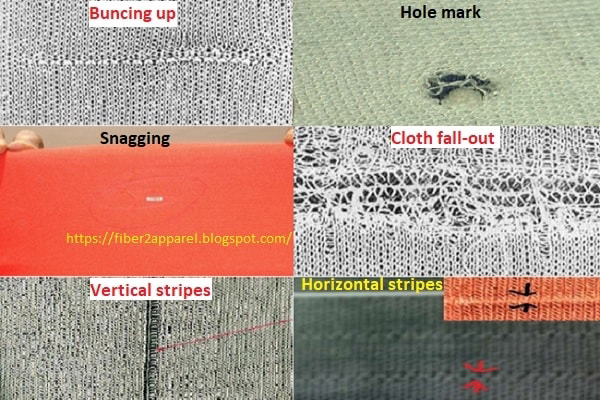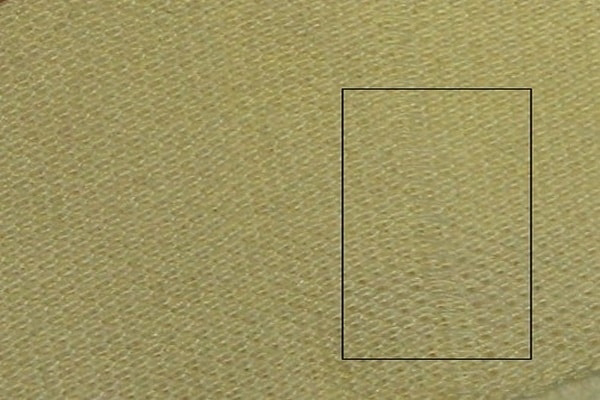KNIT OR KNITTED FABRIC DEFECT WITH CAUSES AND REMEDIES:-
Knit or Knitted Fabric Defects with Causes and Remedies:-
Defination of Knit Fabric in Textile:-
In the textile knitting industry, the fabric which is manufactured by using one set of yarn by interlacing is termed knit fabric. Various types of knit fabrics are 100% cotton single jersey fabric, 100% cotton double jersey fabrics, Burn out single jersey fabrics, Lycra or spandex single jersey fabrics, Grey mélange slub fabrics, Slub single jersey fabrics, Fleece fabrics, French terry slub fabrics, French terry fabrics, Micro or baby terry fabrics, Grey melange fabrics, Lacoste fabrics, etc. Some common fabric defects produced in the knit fabric have been presented in this article with their causes and remedies.
Fig: Knit fabric defects.
Knitting or Knitted Fabric Defects with Causes and Remedies;-
There are various types of knitting faults seen during knit fabric manufacturing. Those are listed below:
1)Broken ends, holes or cracks.
2) Drop stitch,
3) Vertical stripes,
4) Color fly or color triges,
5) Tuck or double loop or stitches,
6) Bunching up,
7) Horizontal stripes,
8) Soil stripes,
9) Snagging or snags,
10) Cloth fall-out,
11) Distorted stitches or deformed or lifted loops.
All the above knitting faults have discussed in the following with their causes and remedies:
1) Broken Ends, Holes, or Cracks:-
Holes are the result of yarn breakage or cracks during knit fabric manufacturing. The yarn had already broken in the region of the needle hook during loop formation.
2) Hole Mark in Fabric:-
Fig: Hole mark in the fabric.
Causes:-
Tension is too high during yarn running.
The yarn is too much dry.
Knots, slubs, etc.
Weak places in the yarn break during stitching or loop formation.
Faulty relation between dial loop and cylinder.
The setting of the yarn feeder is not correct.
Remedies:-
Proper tension should be maintained during yarn running in the knitting process.
Yarn should be kept in an accurate atmosphere.
The proper relation between the cylinder and dial loop.
An accurate setting of the yarn feeder should be maintained.
2. Drop Stitch:-
Drop stitches are the result of the faulty needle. This type of defect is produced when a yarn is not properly fed during stitch or loop formation.
Drop stitch in fabric
Fig: Drop stitch in the fabric.
Causes:-
The faulty setting of the yarn feeder.
Improper yarn feeder threaded-in.
Defective take-up in the knitting process.
Very dry material.
Insufficient yarn tension.
Remedies:-
Proper setting of yarn feeder.
Accurate yarn tension should be maintained.
A fault-free take-up process should maintain during knitting.
Perfect yarn feeder threaded-in.
3. Vertical Stripes:-
It can be found as longitudinal gaps in the fabric. The spaces between wales are irregular and the closed appearance of the fabric is broken up in an unsightly manner.
Fig: Vertical stripes in the fabric.
Causes:-
Heavily running needle.
Defective needle latch.
Defective needle hook.
Defective cylinder or dial.
Bent needles.
Damages on other knitting elements.
Remedies:-
A fault-free needle latch and needle hook should be used in knitting.
Have to confirm defect-free dial or cylinder in a knitting machine.
Damage-free elements should be used in the knitting machine.
4. Color Fly or Color Triges:-
Color fly consists of singe fibers, bunches of fibers of yarn pieces in varying colors. It additionally sticks on the yarn or is knitted into the fabric and very difficult to remove.
Causes:-
Hair with natural dark color, vegetable and food remnants bast, etc., or similar natural remnants in the case of other fibers.
Fly coming from different processing stages during the spinning process. It can only be avoided by a careful operation of individual colors during fabric production.
5. Tuck or Double Loop or Stitches:-
Causes:-
Fabric take-up too weak in the knitting process.
The too much higher setting of the dial-in knitting machine.
The insufficient sliding ability of yarn.
The course density is not set correctly.
Remedies:-
Course density should be set correctly.
The proper sliding ability of yarn is used in knitting.
The perfect setting of the dial-in knitting machine.
6. Bunching Up:-
Visible knots in the fabric are termed as bunching up. They appear as feeds and turn up irregularly in the fabric.
Fig: Bunching up in fabric.
Causes:-
Thick place in yarn.
The fabric takes up too weak in the knitting process.
Remedies:-
Faulty yarn should be avoided in knit fabric manufacturing.
The proper process should be followed in the fabric take-up process in knitting.
7. Horizontal Stripes
This type of fault is caused by unevenness in the courses. Horizontal stripes traverse horizontally and repeat themselves irregularly or regularly.
Fig: Horizontal stripes in the fabric.
Causes:-
Improper setting of yarn feeder.
Comparison in the yarn running-in tension.
Deflectors in dial cam brought into a tuck position.
The jerky impulse from fabric take-up.
At all feeders couriering not constant.
Remedies:-
Proper setting of yarn feeder should be maintained.
Couriering should be constant at all the feeders.
8. Soil Sropes:-
This type of fault can appear both in the direction of courses as well as wales caused by the knitting machine in the knitting industry. It is also known as needle stripes.
Causes:-
A defective automatic greasing or oiling device is used in knitting.
Individual needles have been replaced.
Remedies:-
Defect-free automatic oiling or greasing device should be used.
Individual needles should not be replaced during knitting.
9. Snagging or Snag:-
During the processing of filament yarns, snagging is produced in knit fabric. The tendency can be decreased by using yarn with a lower crimp elasticity, a coarser single filament count, and a higher twist.
Fig: Snagging or snags in the fabric.
10. Cloth Fall-Out:-
Cloth fall-out is an area consisting of drop stitches lying side by side. It is produced when a yarn is laid out or when it breaks without any instant connection.
Fig: Cloth fall-out.
11. Distorted Stitches or Deformed or Lifted loops.
It leads to a very unsettled fabric appearance. This type of defect is most disturbing in single-color yarded fabrics. Here, fabric appearance is skittering.
Ref:-https://www.textiletutorials.com










Comments
Post a Comment